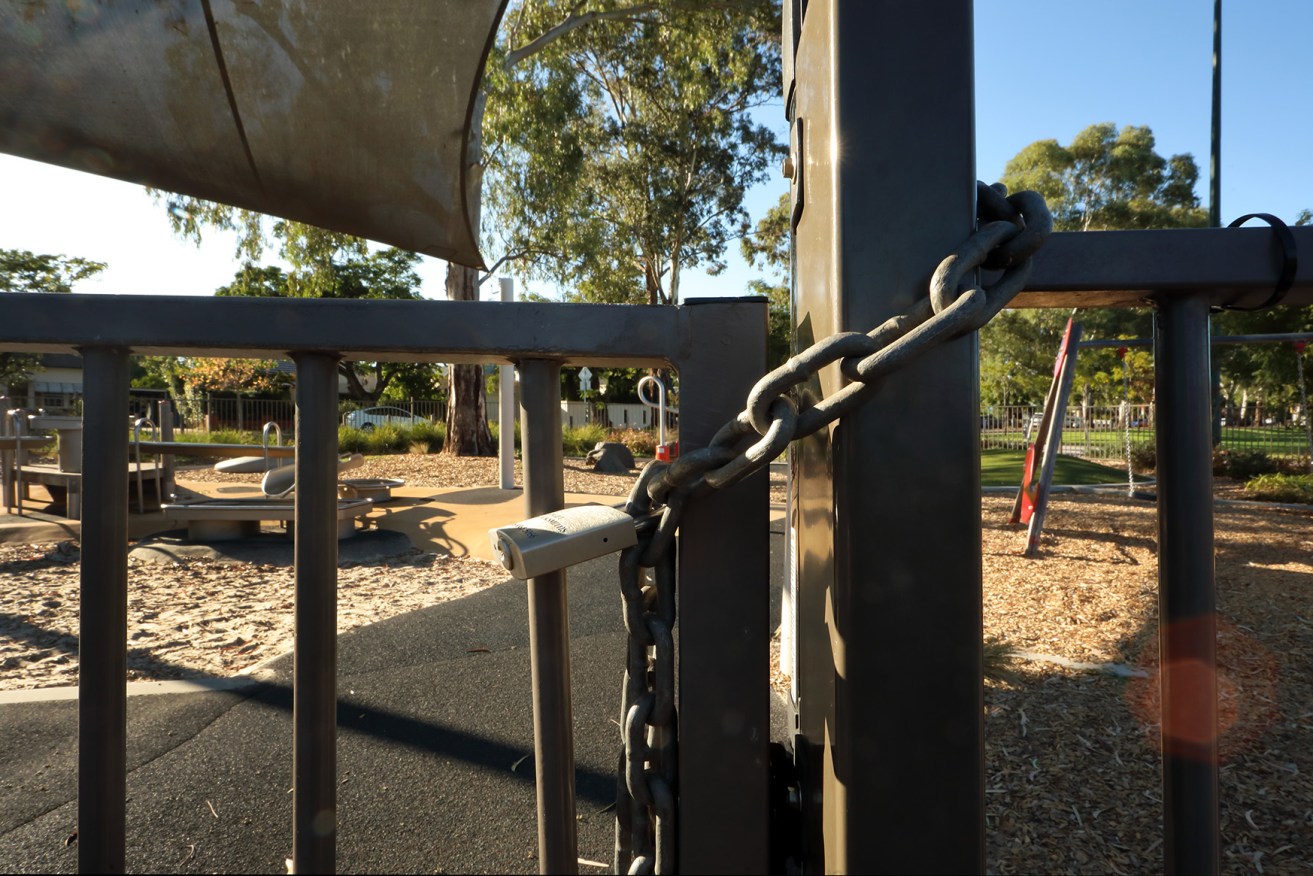Pandemic shutdown sparks big fall in fractures among SA children
Figures showing a dramatic fall in South Australian children rushed to emergency departments with broken bones are among data being examined to help the clinicians prepare better for any future pandemic.


A locked Adelaide playground. Photo: Tony Lewis/InDaily
Health experts instead say far fewer monkey bar and team sport injuries are impacting Women’s and Children’s Hospital figures for April that show broken bones presentations plunged from 349 last year to 203 this year.
There was also a fall in March, from 327 last year to 299 this year.
Head of orthopaedic surgery Associate Professor Nicole Williams said her department was seeing far fewer playground injuries and broken bones from contact sport over weekends.
“Saturday sport is often the busiest times but we do get a number, not large, but a number of kids who injure themselves at school,” Williams said.
“We are really interested in getting all the data, looking at the number of hospital admissions and theatre presentations and looking at how do we staff the department now and if there is another pandemic in the future.”
The department is also tracking how the sudden ramping up of telehealth calls for fractures and breaks was working – a service usually reserved for country patients.
“Coincidentally, we had been working on this area before the COVID-19 restrictions came into place and found 25 per cent of fracture clinic presentations are probably unnecessary,” she said.
Williams said while sports and playground injuries had fallen, there was an increase in the number of children arriving with broken bones from bicycle accidents and home trampoline injuries.
The figures are also sparking discussions about whether children are staying active enough under new virus guidelines.
Professor of health sciences at the University of South Australia Tim Olds said there was likely a link between lower injuries and the ban on organised sport.
“There’s a general feeling that people are reluctant to go to outpatients unless there’s a serious injury, whether it’s over concerns about the virus or not wanting to overburden outpatient departments,” Olds said.
“But the fact that these figures apply to broken bones doesn’t apply here, you don’t say ‘oh, a broken bone I might wait awhile on that’.
“(That means the lower numbers) could be about there being less activities for kids in particular, less activity in contact sports, most injuries come from contact sports in particular netball with ankles, knees and hand injuries, or in football.”
The falling figures reflect statewide data for the first two weeks in April, where South Australian major metropolitan hospitals saw a 32 per cent fall in emergency department presentations with about 8000, compared to the same time last year.
It was the Women’s and Children’s Hospital that had the greatest drop in presentations with a 50 per cent decrease, followed by Flinders Medical Centre at 32 per cent.
There was also a 25 per cent fall in inpatient admissions to our major metropolitan hospitals compared to the same time in 2019.
Olds said the impact of restrictions was far-reaching.
The number of heart attacks being recorded was lower too – and he suggested it may be related to people dealing with less stress in going into a workplace.
While Global Fitbit data showed users across the world are currently 20 per cent less active, Olds believed the figure was likely to be higher for children.
“I suspect with children we will see a much bigger drop off in activity, we’ve stopped team sport, parents would normally take the kids to the park but they are more reluctant to do that,” he said.
“And there is less active transport, most of that is walking to school.”
Dr Jane Webb-Williams is a passionate advocate for play to benefit children’s social and emotional wellbeing, and is a member of the National Board of Play Australia and a committee member of Play Australia.
“I was not surprised when I saw the figures, because of the understanding around COVID-19 and the restrictions it places on daily lives,” said Webb-Williams, who is also an academic at the University of SA.
“It’s closed playgrounds and play spaces, prevented people from playing sports and obviously those things contribute to injuries.”
But she said returning to regular sport and play was important for children’s health and wellbeing to avoid the impacts of being overweight or obese.
“There obviously is a risk on anything we do but the benefits of active play outweighs, in my opinion, the risk of sustaining a minor fracture,” she said.
“But beyond that, outdoor play has benefits beyond physical benefits so important to children’s health and wellbeing we need active outdoor play.”
This article is supported by the Judith Neilson Institute for Journalism and Ideas.





